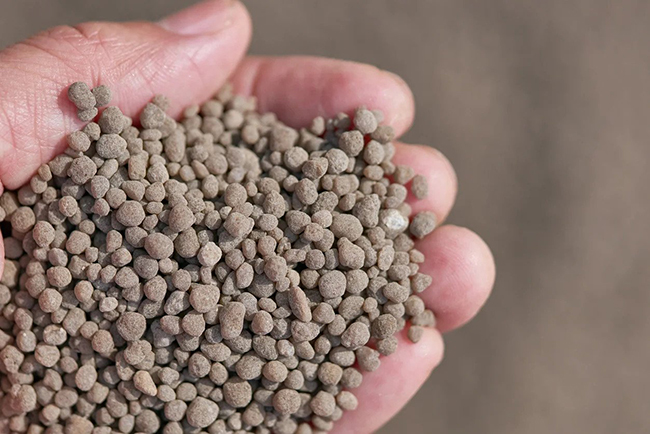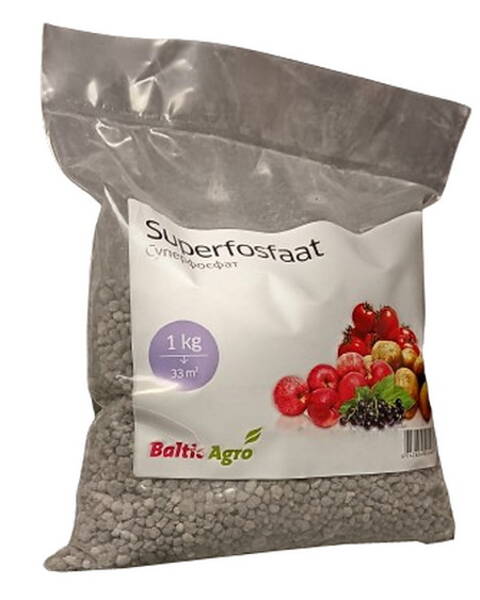Superphosphate is a very effective fertilizer. 1 kg = 33 m2.
A phosphorus based fertilizer can act in several ways:
- improvement of the root system of plants
- maintenance or restoration of healthy plant development and growth
- increase in yields
- improving the quality of the crop (for example, there is a higher protein content in cereals and oilseeds, rapeseed, soybeans)
- slowing down of oxidative processes and strengthening of reduction processes in the soil.

The superphosphate contains: phosphorus, calcium, sulfur, nitrogen and magnesium:
* Sulfur is especially valuable in the cultivation of legumes, grains and oilseeds.
* Calcium neutralizes soil acidity.
* Magnesium is irreplaceable in potato-oriented farms.
Superphosphate fertilizer is offered to the consumer in the form of powder and granules (moreover, the powder version is much cheaper than the granular one, but less effective in a number of applications). Although for the preparation of composts, it is the powder version that is recommended because of the easier mixing and dissolution with other ingredients of complex organo-mineral mixtures.
Application methods: It is advisable to make the main part during the autumn (spring) digging to the depth of soil cultivation (April, September); when sowing or planting (preferably granular) - in holes, grooves, pits (May); as top dressing (June, July, August).
The dosage of superphosphate depends not only on the type of plant, but also on the quality of the soil. For example, for vegetables and herbs, it is recommended to apply from 30 to 40 g per 1 m2 of soil. If the soil is poor, then the fertilizer dosage should be increased by 20-30%.
Superphosphate can not be dug up, mixing with the soil, but simply scattered evenly over the planting area, strictly observing the dosage (indicated on the package).
Application.
Superphosphate is suitable for use on all types of soil and for all crops. But on acidic soils, it is difficult for plants to access, so it should be deoxidized with dolomite flour, lime or ash: add 0.2 kg of ash or 0.5 kg of slaked lime per 1 m2. Remember that superphosphate can be added to the soil no earlier than a month after deoxidation, otherwise it will lose most of its beneficial properties.
Superphosphate is introduced into the soil before sowing the plants during digging, poured directly into the holes (rows) immediately before planting, it is used as top dressing (see the package for the proportion for different garden crops).
Important! When using superphosphate, do not forget the axiom: never mix it with urea, lime, ammonium nitrate and chalk!
Due to the fact that the granules dissolve slowly both in water and in the soil, the effect of granular fertilizer is longer, reaching several months (granular superphosphate is most often used on cruciferous, legumes, cereals and bulbous crops).
Superphosphate can be added to compost, added to the soil when making beds or holes, added to the soil in the fall during digging, scattered over the soil surface or even over the snow, or dissolved in water and used as foliar dressing.
It is most effective to apply this fertilizer precisely in the autumn, so as not to create an overabundance, since during the winter period fertilizers will go into the form most accessible to plants, and in the spring, cultivated plants will take from the soil as much substances as they need.
Usually, in autumn, 45 g per square meter of soil is applied for digging (in spring this amount can be reduced to 40 g). On too poor soils, the amount of this fertilizer can be increased up to 30%.
When added to humus for 10 kg, 10 g of superphosphate is added.
When planting potatoes or vegetables in seedling age in a permanent place, it is advisable to add about half a teaspoon to each hole.
When planting shrubs, it is advisable to add 25 g of fertilizer to each planting hole, and when planting fruit trees, 30 g of this fertilizer.
Superphosphate granules dissolved in water are usually used in spring: it is no secret to anyone that in this way nutrients penetrate into plants as quickly as possible, but you should know that granular superphosphate is very poorly soluble in cold and hard water.
To dissolve it, you must use soft water (ideally rainwater), pouring boiling water (for example, 1 liter). Only then mix this concentrate with the required volume of water (if no rush is required, then the fertilizer can be placed in a dark container by placing it in a sunny place - and the granules will safely dissolve in 2-3 hours).
In order not to dissolve the fertilizer every time, you can prepare a concentrate, for which you should pour 350 g of fertilizer with three liters of boiling water. It remains for a quarter of an hour to stir the resulting composition so that the granules dissolve as completely as possible. Before use, this concentrate should be diluted at the rate of 100 g of concentrate per 10 liters of water. When fertilizing the soil in spring, it is advisable to add 15 g of urea to this concentrate, and in autumn, 450 g of wood ash.












